Configuration - CAs
Tvheadend support connecting to card clients via the cwc (newcamd) and capmt (dvbapi) protocols for so-called ‘softcam’ descrambling.
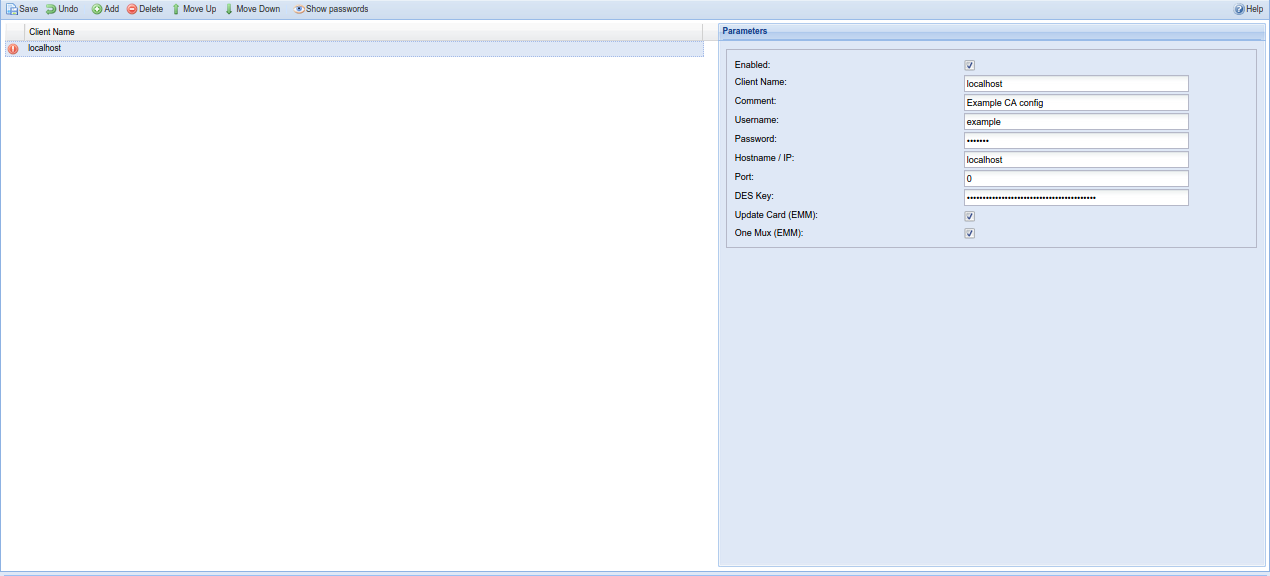
Menu Bar/Buttons
The following functions are available:
| Button | Function |
|---|---|
| Save | Save any changes made to the CA client configuration |
| Undo | Undo any changes made to the CA client configuration since the last save. |
| Add | Add a new CA client configuration. |
| Delete | Delete an existing CA client configuration. |
| Move Up | Move the selected CA client configuration up in the list. |
| Move Down | Move the selected CA client configuration down in the list. |
| Show Passwords | Reveals any stored CA client passwords. |
| Help | Display this help page. |
Add/Edit Dialog Example
New CA configurations are created with the Add button, with subsequent editing done within the grid. The following configuration parameters are used, depending on the type of CA access:
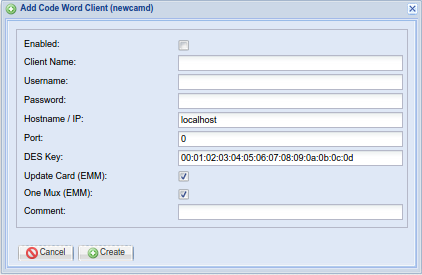
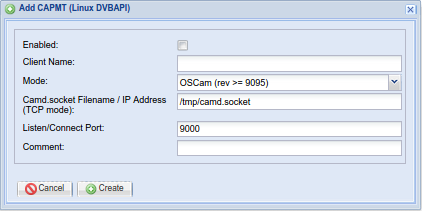
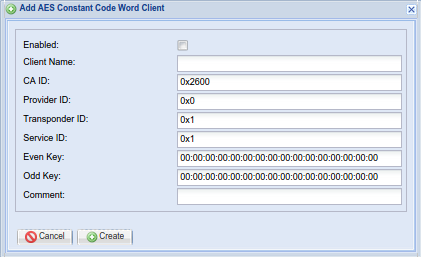
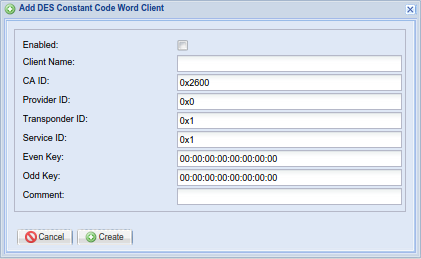
Grid Items
The main grid items have the following functions:
Enabled : If selected, connection will be tried to be established and retained up. If unselected, Tvheadend will disconnect (if connected) and not try to reconnect.
Hostname : Server hostname. DNS lookup is performed upon every connection attempt.
Port : Server TCP port
Username : Username to use.
Password : Password to use.
DES Key : Initial DES key.
Update Card : Forward Entitlement Management Messages (EMMs) to the server.
Update One : Forward EMMs only from one channel at a time.
Comment : Allows the administrator to set a comment only visible in this editor. It does not serve any active purpose.
The columns have the following functions:
Enabled : If selected, connection will be tried to be established and retained up. If unselected, Tvheadend will disconnect (if connected) and not try to reconnect.
Camd.socket Filename / IP Address : Socket filename which is usually opened by cam client. Tvheadend tries to connect to this socket file.
In mode 3 (TCP), enter the IP address of the oscam server. Tvheadend tries to create a TCP connecting to this IP adress and Connect port.
Listen / Connect port : If running on a so called full-featured DVB-Card this can be left empty. Running on Budget-Cards one has to use a dummy ca-device. This is emulated via capmt_ca.so. This module has to be pre-loaded prior to the cam client.
LD_PRELOAD=/path/to/capmt_ca.so cam_client &
This module will communicate the received control-words back to Tvheadend via Port 9000
In mode 3 (TCP), this port is used for the oscam connection. It must be equal to the listen port in the oscam/dvbapi settings.
OSCam mode
-
mode 0 (LD_PRELOAD) : LD_PRELOAD hack is active
-
mode 1 (old OSCam) : If selected, connection will be made directly to oscam without using LD_PRELOAD hack. Port 9000 will be used automatically.
Usage Note for Mode 1
The following lines are required in [dvbapi] section of oscam.conf file:
boxtype = pc
pmt_mode = 4
-
mode 2 (new OSCam since revision 9095) : In this mode, no UDP connections are required. All communication is processed though the Camd.socket. The configuration for OSCam should be same as for mode 1.
-
mode 3 (new OSCam since revision 9574) : A TCP connection to server is created. All emm/ecm data are send to oscam using this connection without a requirement for the real linuxdvb devices in the system with OSCam. This mode is suitable for all DVB devices including SAT>IP and IPTV.
Usage Note for Mode 3
The following lines are required in [dvbapi] section of oscam.conf file:
boxtype = pc
pmt_mode = 4
listen_port = 9000 # or your preferred port
- mode 4 (new OSCam since revision 9754) : Similar to mode 3, but a Camd.socket connection is used instead of the TCP connection.
Usage Note for Mode 4
The following lines are required in [dvbapi] section of oscam.conf file:
boxtype = pc-nodmx
pmt_mode = 4
- mode 5 (new OSCam since revision 10087) : Similar to mode 3 (TCP), but uses a new network protocol which also added client/server greeting messages and protocol version information (to be able to smoothly detect enhancements in the future).
Note
Mode 5 is currently the preferred mode - others may be removed in the future
Usage Note for Mode 5
The following lines are required in [dvbapi] section of oscam.conf file:
boxtype = pc
pmt_mode = 4
listen_port = 9000 # or your preferred port
Comment Allows the administrator to set a comment only visible in this editor. It does not serve any active purpose.